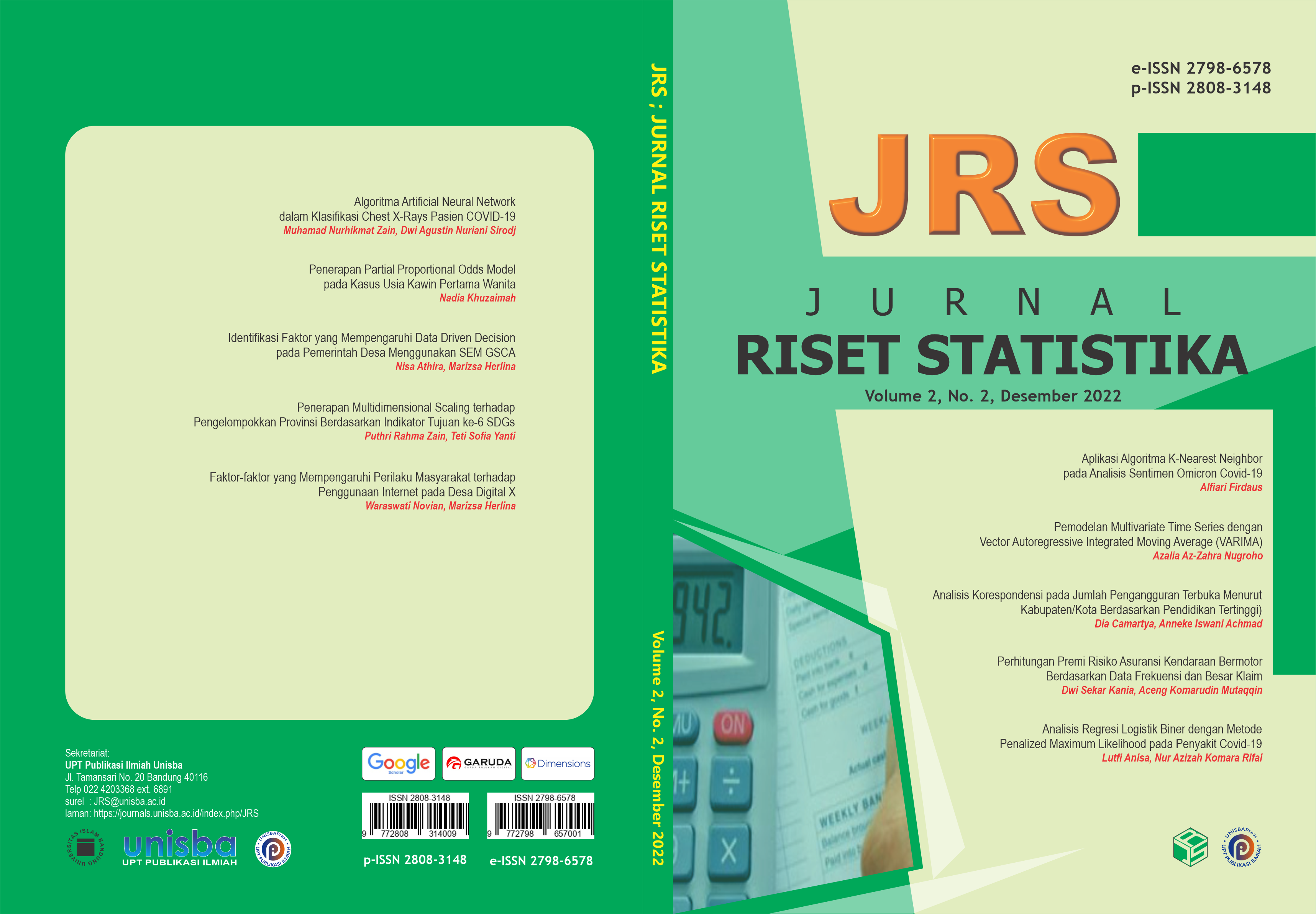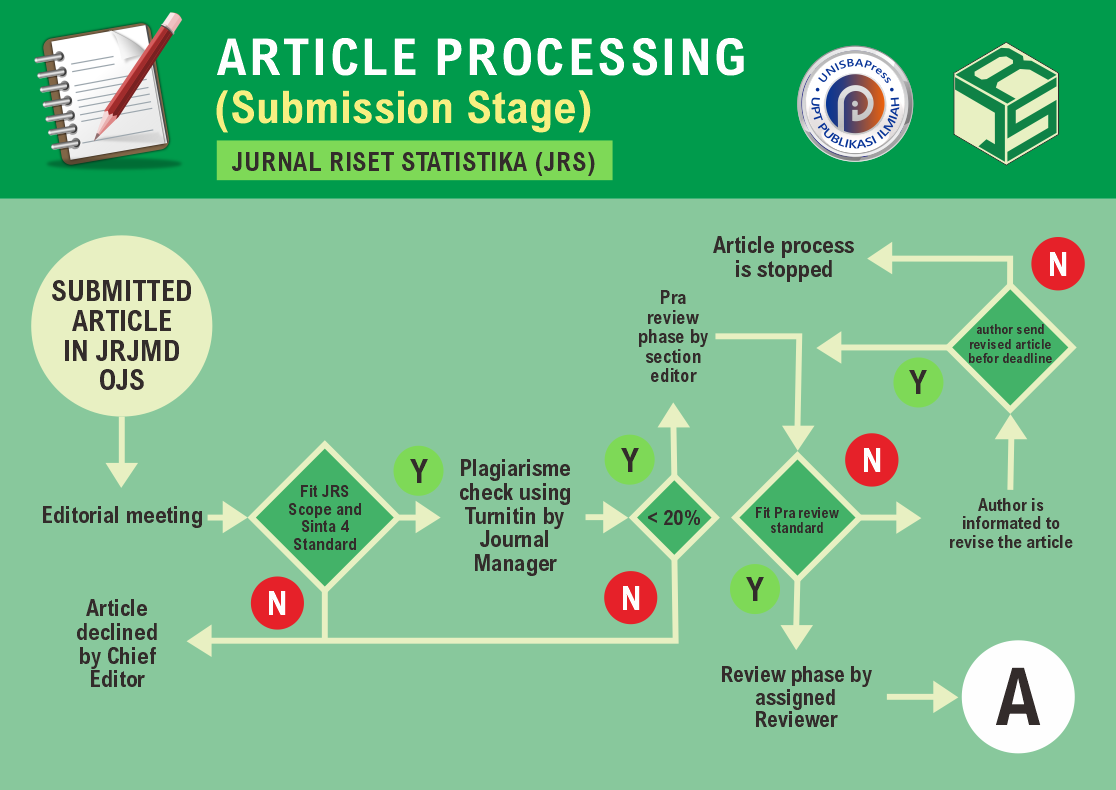Aplikasi Algoritma K-Nearest Neighbor pada Analisis Sentimen Omicron Covid-19
DOI:
https://doi.org/10.29313/jrs.v2i2.1148Keywords:
KNN, Jarak Cosine Similarity, Analisis Sentimen.Abstract
Abstract. K-Nearest Neighbor (KNN) is one of the most widely used classification algorithms in Machine learning methods. KNN classification is a conventional non-parametric classification method that has been used as a primary classifier in many pattern classification problems. The KNN search technique used in this research is the cosine similarity distance formula. The advantage of this method is that it is effective against noise data and is effective when the training data is large. However, this method still has drawbacks, namely the problem of the accuracy of the method used to measure the similarity between the objects being compared. This study aimed to determine the application of the KNN method to sentiment analysis. The data used is 12,951 tweets taken from Twitter using the hashtags #OmicronVariant and #Covid19. The results showed that the best k value parameter was 15. Using the cosine similarity distance, the accuracy was quite good, and the recall was quite good and the precision was good, so the prediction results obtained that the positive category value was higher than the neutral category value and the negative category value. It can be concluded that the public's perception of Covid-19 Omicron is positive, meaning that they believe in Omicron.
Abstrak. K-Nearest Neighbor (KNN) merupakan salah satu algoritma klasifikasi yang paling banyak digunakan dalam metode Machine learning. Klasifikasi KNN merupakan metode klasifikasi non-parametrik konvensional yang telah digunakan sebagai pengklasifikasi dasar dalam banyak masalah klasifikasi pola. Teknik pencarian KNN yang digunakan dalam penelitian ini dengan menggunakan rumus jarak cosine similarity. Keuntungan dari metode ini adalah efektif terhadap data noise dan efektif ketika data training berukuran besar. Namun metode ini masih memiliki kekurangan yaitu masalah tingkat akurasi metode yang digunakan untuk mengukur kemiripan antar objek yang dibandingkan. Tujuan dari penelitian ini adalah untuk mengetahui penerapan metode KNN pada analisis sentimen. Data yang digunakan adalah data tweet sebanyak 12.951 yang diambil dari twitter dengan menggunakan hastag #OmicronVariant dan #Covid19. Hasil penelitian menunjukkan bahwa parameter nilai k terbaik adalah 15. Menggunakan jarak cosine similarity akurasi cukup baik, dan recallnya pun cukup baik kemudian presisinya baik, maka hasil prediksi diperoleh nilai kategori positif lebih tinggi dibandingkan nilai kategori netral dan nilai kategori negatif. Dapat disimpulkan bahwa persepsi masyarakat terhadap Covid-19 Omicron adalah positif, artinya mereka percaya dengan adanya Omicron.
References
M. AE, “Comparative Study of Machine Learning Techniques for Supervised Classification of Biomedical Data,” Int. J. Appl. Sci. Technol., vol. 7, no. 2, pp. 5–18, 2017.
R. Samuel, R. Natan, and U. Syafiqoh, “Penerapan Cosine Similarity dan K-Nearest Neighbor ( K-NN ) pada Klasifikasi dan Pencarian Buku,” J. Big Data Anal. Artif. Intell., vol. 1, no. 1, pp. 9–14, 2018.
Anggi Priliani Yulianto and S. Darwis, “Penerapan Metode K-Nearest Neighbors (kNN) pada Bearing,” J. Ris. Stat., vol. 1, no. 1, pp. 10–18, Jul. 2021, doi: 10.29313/jrs.v1i1.16.
A. K. Jain, R. P. W. Duin, and J. Mao, “Statistical pattern recognition: A review,” IEEE Trans. Pattern Anal. Mach. Intell., vol. 22, no. 1, pp. 4–37, 2000, doi: 10.1109/34.824819.
S. A. Alasadi and W. S. Bhaya, “Review of data preprocessing techniques in data mining,” J. Eng. Appl. Sci., vol. 12, no. 16, pp. 4102–4107, 2017, doi: 10.3923/jeasci.2017.4102.4107.
C. D. Manning, P. Raghavan, and H. Schutze, An Introduction to Modern Information Retrieval, Online Edi., vol. 53, no. 9. Cambridge: Cambridge University Press, 2009. doi: 10.1108/00242530410565256.
B. G. Batchelor, Pattern Recognition: Ideas in Practice. 2011.
J. Singh, G. Singh, and R. Singh, “A review of sentiment analysis techniques for opinionated web text,” CSI Trans ICT, vol. 4, no. 2–4, pp. 241–7, 2016.
M. H. Syahnur, M. A. Bijaksana, and M. S. Mubarok, “Kategorisasi Topik Tweet di Kota Jakarta , Bandung , dan Makassar dengan Metode Multinomial Naïve Bayes Classifier Program Studi Sarjana Teknik Informatika Fakultas Informatika Universitas Telkom Bandung,” vol. 3, no. 2, pp. 3612–3620, 2016.
F. Pozzi, E. Fersini, E. Messina, and B. Liu, Sentiment Analysis in Social Networks. Morgan Kaufmann, 2016.
D. S. Rajput, R. S. Thakur, and S. M. Basha, Sentiment Analysis and Knowledge Discovery in Contemporary Business. India, 2018.













